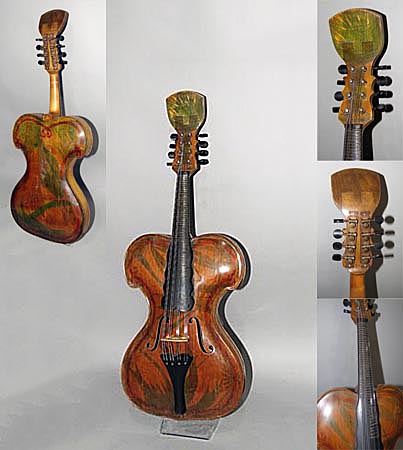
Owner: HWMC
Catalog#: CL-CHLT-59
Violin Family
Hungarian 'Folk Fiddle' - 19th century
Hungary (possibly)
Unknown Maker
Wood, metal, ebony, paint
ca. Mid-Late 19th century
Length: 27 in; Width: 10.5 in
Strings – Lutes – Violin Family
This 1800s folk fiddle is built with an arched bridge for melodic playing. It has 8 metal strings (4 pairs) and a violin-shaped arch top and body with 47 metal (copper) frets – 33 full and 14 half frets on the extended neck fingerboard. The top peg head shows mechanical tuners and is flat, similar to a mandolin or guitar peghead, which is unlike a violin scroll. This somewhat reminds me of the Alpine zither (streichzither). It has an ebony endpin, pegs, and finger board, with F-shaped sound holes. The top and back are painted with green and red leafage. There are no markings of identification. Possibly a folk fiddle from Eastern Europe (Hungary).
The word violin comes from the Latin (Middle Ages) word “vitula,” meaning stringed instrument. It is also believed to be the source of the Germanic term “fiddle”. The violin acquired most of its modern characteristics in the 16th century in Italy, with further modifications occurring through to the 18th century, particularly by such makers as Gasparo da Salo, Geovanni Paola Magginig, Stradivari, Guarneri and Andrea Amati in Brescia and Cremonia and by Jacob Stainer in Austria.
The earliest string instruments were most likely plucked such as the Greek lyre. Bowed instruments may have originated in the equestrian cultures of Central Asia, such as the Turkish ‘Kobyz’ or the Mongolian ‘Morin huur.” (Both found in this collection.) These instruments spread to China (‘erhu’), India (‘esraj’), the Byzantine Empire (‘lyria’) and the Middle East/Arabic (‘rebab’). The Italian port towns of Venice and Genoa maintained close ties to central Asia through the trade routes of the silk road, through which the knowledge and examples of these instruments surely traveled, and eventually spreading throughout Europe.
The modern violin most likely evolved from the ‘rebec’ that was in use since the 10th century, the Renaissance fiddle (viol), and the ‘lira da braccio.’
Resource: https://www.feheraniko.hu/en/instruments/hungarian-folkmusic-instruments
